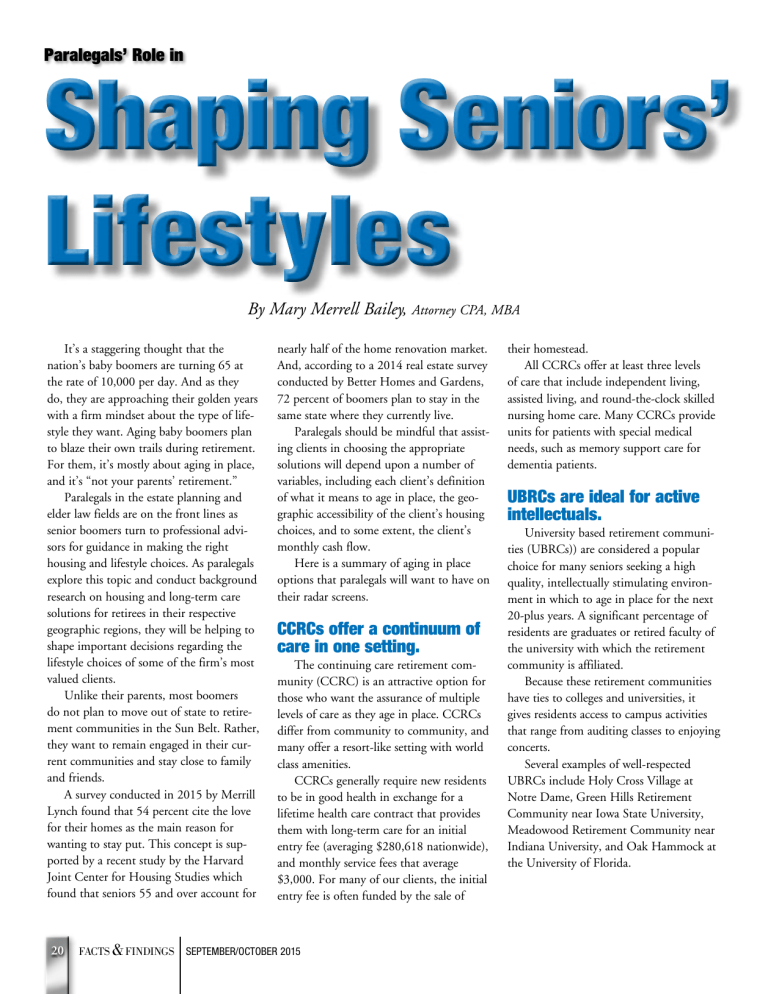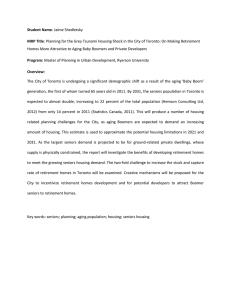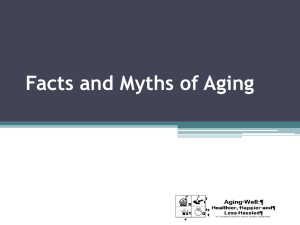CCRCs offer a continuum of care in one setting. UBRCs are ideal for

Paralegals’ Role in
Shaping Seniors’
Lifestyles
By Mary Merrell Bailey, Attorney CPA, MBA
It’s a staggering thought that the nation’s baby boomers are turning 65 at the rate of 10,000 per day. And as they do, they are approaching their golden years with a firm mindset about the type of lifestyle they want. Aging baby boomers plan to blaze their own trails during retirement.
For them, it’s mostly about aging in place, and it’s “not your parents’ retirement.”
Paralegals in the estate planning and elder law fields are on the front lines as senior boomers turn to professional advisors for guidance in making the right housing and lifestyle choices. As paralegals explore this topic and conduct background research on housing and long-term care solutions for retirees in their respective geographic regions, they will be helping to shape important decisions regarding the lifestyle choices of some of the firm’s most valued clients.
Unlike their parents, most boomers do not plan to move out of state to retirement communities in the Sun Belt. Rather, they want to remain engaged in their current communities and stay close to family and friends.
A survey conducted in 2015 by Merrill
Lynch found that 54 percent cite the love for their homes as the main reason for wanting to stay put. This concept is supported by a recent study by the Harvard
Joint Center for Housing Studies which found that seniors 55 and over account for nearly half of the home renovation market.
And, according to a 2014 real estate survey conducted by Better Homes and Gardens,
72 percent of boomers plan to stay in the same state where they currently live.
Paralegals should be mindful that assisting clients in choosing the appropriate solutions will depend upon a number of variables, including each client’s definition of what it means to age in place, the geographic accessibility of the client’s housing choices, and to some extent, the client’s monthly cash flow.
Here is a summary of aging in place options that paralegals will want to have on their radar screens.
CCRCs offer a continuum of care in one setting.
The continuing care retirement community (CCRC) is an attractive option for those who want the assurance of multiple levels of care as they age in place. CCRCs differ from community to community, and many offer a resort-like setting with world class amenities.
CCRCs generally require new residents to be in good health in exchange for a lifetime health care contract that provides them with long-term care for an initial entry fee (averaging $280,618 nationwide), and monthly service fees that average
$3,000. For many of our clients, the initial entry fee is often funded by the sale of their homestead.
All CCRCs offer at least three levels of care that include independent living, assisted living, and round-the-clock skilled nursing home care. Many CCRCs provide units for patients with special medical needs, such as memory support care for dementia patients.
UBRCs are ideal for active intellectuals.
University based retirement communities (UBRCs)) are considered a popular choice for many seniors seeking a high quality, intellectually stimulating environment in which to age in place for the next
20-plus years. A significant percentage of residents are graduates or retired faculty of the university with which the retirement community is affiliated.
Because these retirement communities have ties to colleges and universities, it gives residents access to campus activities that range from auditing classes to enjoying concerts.
Several examples of well-respected
UBRCs include Holy Cross Village at
Notre Dame, Green Hills Retirement
Community near Iowa State University,
Meadowood Retirement Community near
Indiana University, and Oak Hammock at the University of Florida.
20 FACTS
&
FINDINGS SEPTEMBER/OCTOBER 2015
The “village movement” is growing from coast to coast.
The village movement seems to be catching on with seniors of all income brackets who want to age in place at home and within their communities. This model is a membership-driven, local grassroots non-profit organization through which volunteers and paid staff coordinate access to affordable services including transportation, health and wellness programs, home repairs, social activities, and other daily needs so that aging seniors may stay in their homes and remain connected to their community.
The Village-to-Village Network is a related, but separate, non-profit organization that tracks and coordinates villages around the country. Most villages are located in densely-populated, upper income urban areas and are funded through a combination of membership dues, government grants and corporate sponsors. There are nearly 150 organizations currently operating around the country and more are in the formation stages.
Cohousing communities promote social connectivity.
Another option for seniors who want to avoid the isolation of institutional living is the cohousing model designed to promote social connectivity and to avoid the isolationism of suburban developments.
Members usually maintain private residences but share common spaces such as dining areas and recreational facilities. While some cohousing communities cater exclusively to retirees, others are designed for an intergenerational experience.
While California, Colorado,
Massachusetts, North Carolina and
Washington State appear to have the greatest number of cohousing communities, other states, including Florida, either have sites under development or in the early planning stages.
A Virtual Network for the
Golden Years.
Another virtual-type aging in place solution designed for single mature adults who want to stay in their neighborhoods, but who do not want to live alone, has emerged. The Golden Girls Network, featured last year on the PBS News Hour, started in 2014 as a nationwide electronic database designed to help mature adults
(both women and men) find roommates and ease their way into shared living. Based in Bowie, Maryland, the organization also has a “Home Companion” program that assists seniors in finding a suitable live-in companion who can share activities and help with household chores.
The paralegal’s research role cannot be overstated, as it is often through their efforts that attorneys walk into client meetings armed with updated knowledge on the demographic and psychographic trends of the folks sitting at the conference table.
As trusted advisors, we should help our aging clients think about their retirement years in three phases:
• the active phase involving travel and hobbies
• the slowing down phase where mobility becomes limited
• the custodial period
Finally, legal advisors should remind clients to think long term. Ideally, it is best to help clients plan now for later so they can avoid facing limited options when a major health crisis suddenly occurs.
Once paralegals have researched all the options within their respective communities, they should consider summarizing the information into a one-page fact sheet to facilitate talking points during client conferences. The firm also may want to host client seminars on this topic.
Mary Merrell Bailey, Attorney, CPA, MBA is the managing partner of Your Caring Law Firm, a boutique law firm in
Maitland, Florida offering wills, trusts and guardianships, as well as business succession, asset protection, estate planning, and trust administration services.
The firm also handles probate matters throughout the state of Florida.
Merrell and her partner
Hallie Zobel offer clients compassionate legal counsel on very private family matters.
Merrell@yourcaringlawfirm.com
SEPTEMBER/OCTOBER 2015 FACTS
&
FINDINGS 21


